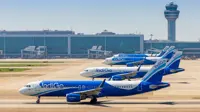Cabinet approves nine rail infrastructure projects worth Rs24,000 cr
25 Aug 2016
The Cabinet Committee on Economic Affairs (CCEA) on Wednesday approved nine railway infrastructure projects, spread across nine states and involving total expenditure of about Rs24,000 crore, for expansion of railway network and connectivity across the country.
The rail infrastructure projects that the CCEA chaired by Prime Minister Narendra Modi has given the green signal includes massive line expansion involving track construction of a total length of 1,937.38 km at an estimated cost of Rs24,374.86 crore, said a CCEA release.
These include the construction of a third line between Itarsi and Nagpur at an estimated cost of Rs2,449.91 crore and expected completion cost of Rs.2,882.94 crore. The 280-km long railway line is expected to be completed in five years.
Besides facilitating the travel, industries in and around Itarsi-Nagpur route will have additional transport capacity to meet their requirements. The new line will cover Hoshangabad, Chhindwara and Betul districts of Madhya Pradesh and Nagpur district of Maharashtra.
The Itarsi-Nagpur route is a broad gauge double electrified line serving passenger as well as goods traffic from North to South. The line capacity utilisation of the section is saturated and running of additional mail / express and goods trains over the section cause congestion.
The CCEA also approved a third line between Ballarshah and Kazipet at an estimated cost of Rs2,063.03 crore and expected completion cost of Rs2,403.22 crore. The 201.04-km-long railway line is expected to be completed in five years.
Besides facilitating the travel, power plants, coal and cement traffic will have additional transport capacity to meet their requirement. It will cover Warangal, Adilabad and Karimnagar districts of Telengana and Chandrapur district of Maharashtra.
Ballarshah-Kazipet third line is a part of the New Delhi-Chennai Grant trunk route and golden quadrangle. The section between Ballarshah-Kazipet has reached saturation level. The section is extremely important from goods loading point of view with FCI siding at Jammikunta, Kesoram Cement siding at Raghavpuram, thermal power station and SCCL siding at Manchiryal, coal loading sidings at Bellampalli, Rechni Road, Asifabad and cement loading siding at Manikgarh, Ghatchandur.
The CCEA approved the construction of a third line between Jhansi and Bina at an estimated cost of Rs2,001.63 crore and expected completion cost of Rs2,273.84 crore. The 152.57-km-long railway line is expected to be completed in four years.
Besides facilitating the travel, goods trains passing through this section will get adequate capacity for smooth running. Jhansi and Lalitpur districts of Uttar Pradesh and Sagar district (Bina) of Madhya Pradesh will be covered by this line.
Jhansi-Bina section is a broad gauge double line on New Delhi-Mumbai CST route. This project will enhance capacity, reduce detention and cater for future growth of traffic.
CCEA also approved the construction of a third line between Vijaywada Junction and Gudur Junction at an estimated cost of Rs3,246.26 crore and expected completion cost of Rs3,875.68 crore. The 287.67-km-long railway line is expected to be completed in six years.
Besides facilitating the travel, foodgrains traffic to southern states and goods traffic for Krishnapatnam and nearby ports will have additional transport capacity to meet their requirement. Krishna, Guntur, Prakasham and P.S. Nellore districts of Andhra Pradesh will be covered by this line.
Vijawada Junction-Gudur Junction line is a part of grand trunk route connecting north and south states. This section serves freight trains catering to demands of various loading points. Foodgrains to southern states are moved through this section. Besides this, goods traffic from Krishnapatnam and nearby ports will increase in the section necessitating for construction third line of Vijayawada Junction and Gudur Junction.
These projects, which include seven third line, one fourth line and one doubling, are essentially required for removing capacity constraints, reducing detention and to cater for traffic growth in future.






















